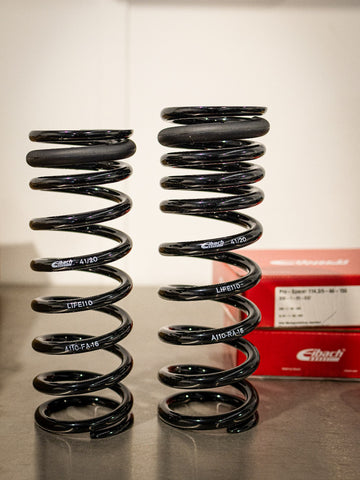Progressive springs aren’t what you think.

I’m often asked about the advantage that progressive springs bring to the aftermarket world. My Life110 sports springs are progressive for both front and rear axles and the public assumption is they must be better. I could sit back and let the assumption continue, after all I’m trying to sell a tuning part, but the reality is they are a necessity.
The first step in the vehicle dynamicists’ guide to suspension tuning is to determine the spring rates. How stiff you make these springs affects the character of the car, from soft to sporty, cornering angle to balance. Of course there are 1000 steps, and more, that follow but it’s the first fundamental to tackle.
For such an important component you’d think a bit of clever tech would really help. I see and hear often how a progressive spring is a worthy upgrade from a standard, linear spring. As the coils of the progressive spring wind closer and closer together at one end it will become gradually stiffer as you compress it. Soft for ride and then stiff for handling. Who wouldn’t want that bit of magic?
So, when I say that progressive springs aren’t soft or stiff depending on the road, bumps, or corners you are taking, you’ll be left wondering just what exactly are they for?
The explanation lies in the trade between wheel travel and spring stiffness. All cars need healthy amounts of wheel travel to deal with the bumps, crests, pot holes and speed bumps the roads throw at them. Take a car at its natural ride height and the wheel will need travel in rebound, as the body rises until the wheels come off the ground, just as much as it needs travel into bump, where the wheel is moving up into the wheel arch.
Now consider spring stiffness. The stiffer you make a spring the faster it loads up as you compress it. This means the wheel will have less travel up into the wheel arch as the car goes over a bump because the spring is stiffer. The flip side of this stiffness is the spring also unloads faster into rebound. As the car rises, say over a crest, the spring unloads quickly, and for small amounts of travel. A stiff spring could become completely unloaded to the point it is rattling around, and in the extreme fall out, before the wheel even reaches its full rebound travel.
It is in this scenario the progressive part comes into play. As the spring unloads into rebound the progressive coils open (those closer wound coils at one end) and the spring becomes softer, which extends the travel, and the spring remains loaded.
This is the answer for why you want a progressive spring – to allow you to choose a stiffer spring rate whilst maintaining wheel travel.
I guess it’s easy to understand the myth that progressive springs get stiffer into bump when you need it (indeed this is true for a motorbike, or maybe a van or truck with high payload, and for a rally car) but what it actually happening is they get softer into rebound when you need it.
Given the progressive part only happens well away from normal ride height, it’s clear that during road driving the spring maintains the same rate, there’s no soft for ride and stiff for handling. But there will be times when you want to push the character to the sporty side, or lower the ride height, and you can thank the progressive spring for a wider range of possibilities at that first step.

Are progressive springs best front and rear? Thanks. GB
So progressive springs are like helper springs.
Thank you so much its useful info
Nice for someone to take the time to explain this.
Great explanation of the basics of progressive springs. Dispelling the myths, sticking to the engineering. Good work.